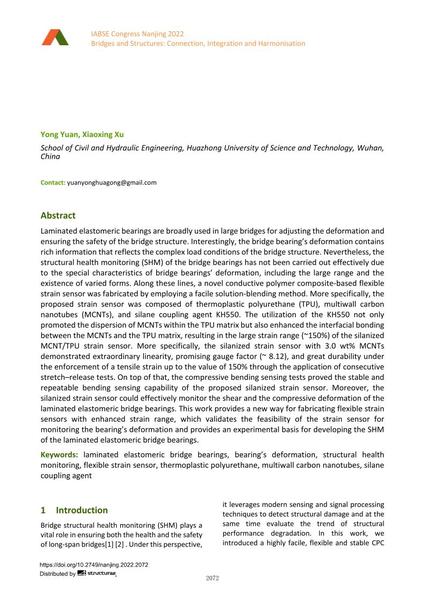A Silanized MCNT/TPU-based Flexible Strain Sensor with High Stretchability for Deformation Monitoring of Laminated Elastomeric Bridge Bearings

|
|
|||||||||
Détails bibliographiques
| Auteur(s): |
Yong Yuan
(School of Civil and Hydraulic Engineering, Huazhong University of Science and Technology, Wuhan, China)
Xiaoxing Xu (School of Civil and Hydraulic Engineering, Huazhong University of Science and Technology, Wuhan, China) |
||||
|---|---|---|---|---|---|
| Médium: | papier de conférence | ||||
| Langue(s): | anglais | ||||
| Conférence: | IABSE Congress: Bridges and Structures: Connection, Integration and Harmonisation, Nanjing, People's Republic of China, 21-23 September 2022 | ||||
| Publié dans: | IABSE Congress Nanjing 2022 | ||||
|
|||||
| Page(s): | 2072-2073 | ||||
| Nombre total de pages (du PDF): | 2 | ||||
| DOI: | 10.2749/nanjing.2022.2072 | ||||
| Abstrait: |
Laminated elastomeric bearings are broadly used in large bridges for adjusting the deformation and ensuring the safety of the bridge structure. Interestingly, the bridge bearing’s deformation contains rich information that reflects the complex load conditions of the bridge structure. Nevertheless, the structural health monitoring (SHM) of the bridge bearings has not been carried out effectively due to the special characteristics of bridge bearings’ deformation, including the large range and the existence of varied forms. Along these lines, a novel conductive polymer composite-based flexible strain sensor was fabricated by employing a facile solution-blending method. More specifically, the proposed strain sensor was composed of thermoplastic polyurethane (TPU), multiwall carbon nanotubes (MCNTs), and silane coupling agent KH550. The utilization of the KH550 not only promoted the dispersion of MCNTs within the TPU matrix but also enhanced the interfacial bonding between the MCNTs and the TPU matrix, resulting in the large strain range (~150%) of the silanized MCNT/TPU strain sensor. More specifically, the silanized strain sensor with 3.0 wt% MCNTs demonstrated extraordinary linearity, promising gauge factor (~ 8.12), and great durability under the enforcement of a tensile strain up to the value of 150% through the application of consecutive stretch–release tests. On top of that, the compressive bending sensing tests proved the stable and repeatable bending sensing capability of the proposed silanized strain sensor. Moreover, the silanized strain sensor could effectively monitor the shear and the compressive deformation of the laminated elastomeric bridge bearings. This work provides a new way for fabricating flexible strain sensors with enhanced strain range, which validates the feasibility of the strain sensor for monitoring the bearing’s deformation and provides an experimental basis for developing the SHM of the laminated elastomeric bridge bearings. |
||||
